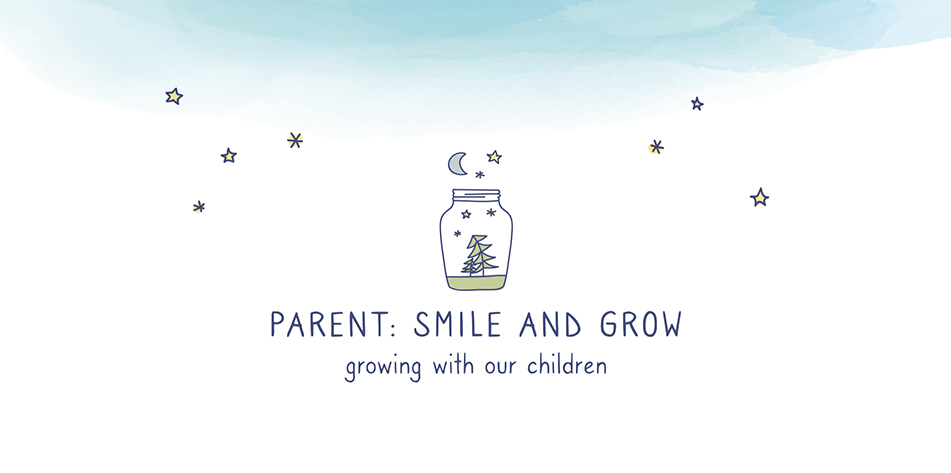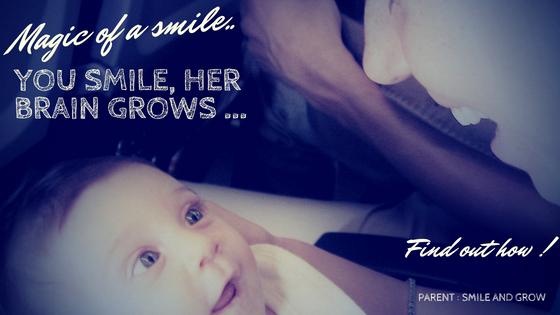Have you ever noticed that when you have a baby in your arms, she starts to flicker as soon as you are a little tense? And that generally, smiling at him tenderly has a soothing effect? Have you ever been so tired, and ended with thinking unconsciously that your baby was crying on purpose to annoy you? Would that be possible? Let’s see what’s going on in the baby’s brain, and how we can help it grow!
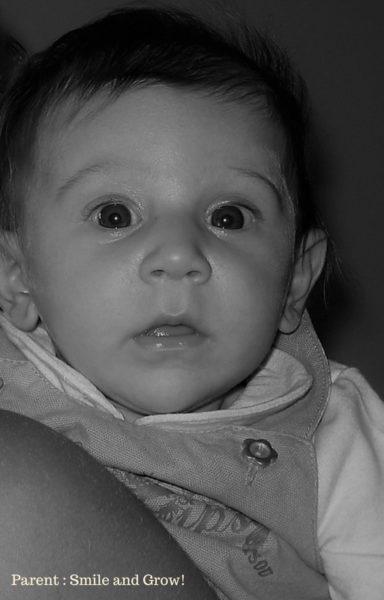
Table of Contents
Baby’s brain is a sponge
When I became a mother, I was at first puzzled to realize that my tiny baby was so permeable to my emotional states. When I was cool and relaxed and happy, she was the easiest company; whenever I felt tired, distressed, tensed or nervous, well, things weren’t that simple then.
She would cry or want me more, making sometimes my tension longer to dissolve. At that time, I was still miles away from all the readings and discoveries I’ve done ever since. I was just exploring a new dimension of the world, and of myself.
Because of my doing 3 things at once, I used to move fast, to run; therefore clumsily dropping things, hurting things on my way, making noises…
Well, rough and noisy wasn’t that good for a new born, I’d found out. She would freak out at sudden loud noises; her body would “jump up”, from a state of calmness to one of alert.
I started to pay attention to subtleties, to the tone of my voice, to how I moved. Songs were great, as they kept me quiet, and cuddled her at the same time.
I had her on me most of the times, in my arms or in a baby carrier, so we were in constant physical contact. She could so easily sense the variations of my breathing speed, and I had to better manage myself.
It was a very happy period for me, so it wasn’t that difficult per se; but I was amazed at how I could keep her calm just by being calm and happy myself.
The science of emotional transfer
According to the studies in social intelligence, this is a normal “transfer of feeling” that occurs during interactions (I’m more particularly referring here to Daniel Goleman's book, 'Social Intelligence“; chapter 1 to be precise).
The main responsible for this phenomenon is the amygdala, which particularly activates our subconscious attention for others’ emotional signals when a potential threat is perceived.
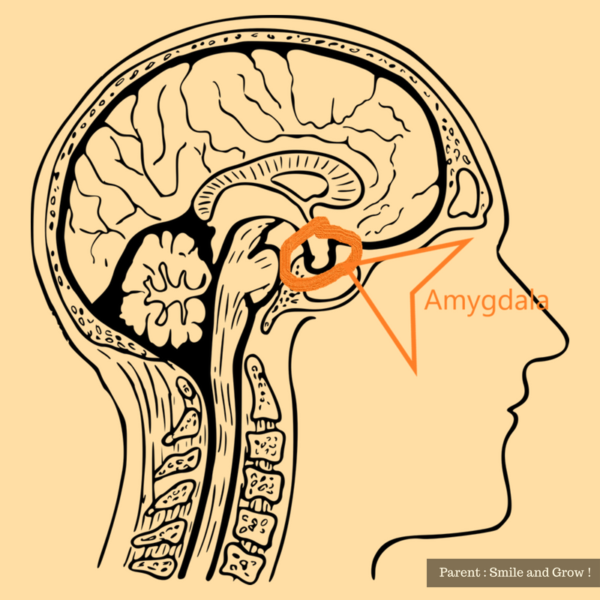
What is interesting, is that the amygdala does not have a direct link to the centers for speech in our brain. It identifies emotional meaning out of what we see, and it represents it by transferring this emotion in us, so that we can feel that same emotion we just saw in the other person, without us being aware of it.
Daniel Goleman describes this processing as the “low road”, as opposed to the “high road” which works within the neural system, signaling to the prefrontal cortex, where we “think” about what is happening, with our consciousness. Where the high road mode requires our attention, time and some effort, but is “more accurate”, the low road functions faster and gives a raw result.
The amygdala in our baby’s brain
Let’s come back to our baby. Babies are born with a fully-functioning amygdala, so they can actually feel a lot of intense emotions; these are stored in what is called implicit memory. Other areas of the brain, such as the hippocampus (responsible for processing narrative memory), are not yet fully mature.
This means that babies can sense the emotions they see in us. They feel them and register them, but cannot make sense of what they perceive. So we need to gradually teach them how.
That’s why my daughter is afraid of spiders 🙁
The needy baby.. and us
Let’s take our initial image. My clumsy, noisy self; in my arms, my baby daughter getting nervous when I was. Because, notwithstanding my unconditional love for her, sometimes I would have liked to cook or do the laundry without having to hold her the whole time.
Babies need us so much for survival.. more than what we imagine. For instance, at the time I didn’t know that they regulate their heart rate on ours. As their immune system.. and even their muscular activity.
This is called early regulation, and it refers to all the internal states of a baby : physical and emotional. At the very beginning, this is done through touch; then, all the other senses come into play. It is a constant exchange between external and internal systems; between emotions and physical reactions; between the mother’s actions and the baby’s.
This is what makes taking care of a baby so.. intense. Biologically, it works best when the mother can completely identify with her baby’s needs. The more intensively I feel my baby’s discomfort, the faster I will take action to bring back my baby to a calmer state. Better chances of survival…
The baby’s brain adjusting to her world
As babies, we do learn to regulate ourselves through the help of another person, by connecting to her feelings, and readjusting accordingly.
This ability to correctly interpret other people’s needs and feelings allows us to take our place into the social world we live in, to maintain the essential relationships we need to survive by reciprocally adjusting to each other.
What are feelings then? From birth on, feelings, emotions are signals. They are alarm bells telling us “Hey! Pay attention! There’s something worth noticing here! Better focus and decide how you want to react to this!”
They alert us on whether we should continue, get closer; or leave. Leave when the relationship threatens us; or take action to maintain it when we need it.
Newborns and their brain
I don’t know about you, but I find all this extremely interesting. What happens in our heads, and in our children’s, just explains the little discrepancies in our behavior.. For instance, let’s think about this : when we are 12 months old, our brains reach the same developmental stage as animals at birth.
You’d think this is crazy right?! Well, the reason to that is that our brain largely develops according to our experiences, especially the social ones.
Therefore, at birth, we can adapt to any social context we are born in. One practical example of it can be seen in language : during the first 12 months (and even in the womb actually), our ears are able to detect and register the sounds of any language in the world, preparing us to reproduce them in the same exact way.
After 12 months, we focus on the language(s) we hear, but we can no longer detect certain sounds that are absent from our social context.
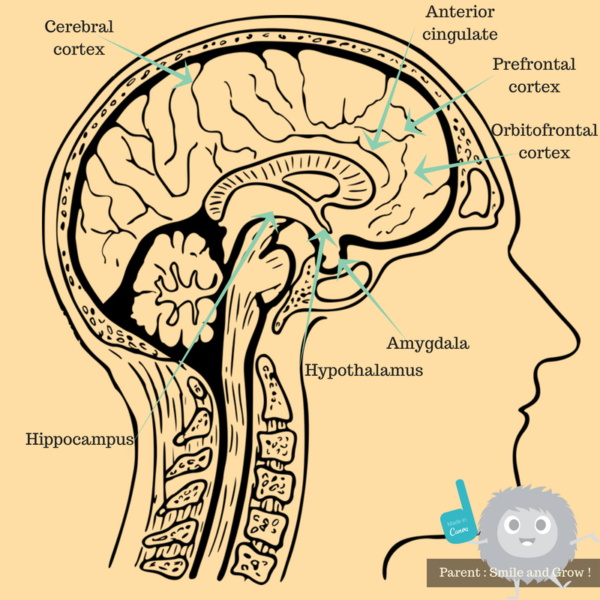
Some more details of a baby’s brain.
Here in this really schematic picture, we find the main brain parts. We are born with pre-motor cortex and anterior cingulate cortex all ready to go. This allows our newborns to connect to other people especially through touch, and gradually more to visual expression and body language. Why? Biologically, the baby needs :
- to regulate her internal states. Heart rate, blood pressure, muscular tension.. Baby takes it from the adult holding her. That’s why our babies feel we’re nervous and become nervous as well!
- to adapt to the specific context she’s born in. Biologically, she needs to learn fast to catch other people’s intentions and how to react.
On the contrary, the last part of the brain to mature is the prefrontal cortex. It’s mostly developed by 5, but actually complete its growth at age 25.. As you may already know, this is the part of our brain that analyzes situations in their complex and then takes decisions.
So what happens in between?
How brain develops
During the first two months after birth, the anterior cingulate develops. This is the part that surrounds main “emotional center”, where amygdala and hippotalamus are. It registers the baby’s emotional states, and learns how to react in order to achieve a positive state. Basically, that’s what helps baby understand that when she cries, her mom will come soothe her, when she smiles, mom smiles too, and so on. As the child grows, this part of his brain will allow to control impulses.
At the same time, also the orbito-frontal cortex develops. It’s what allows us to identify feelings, ours or the others’, so it’s the center for empathy. As this part develops, we learn to manage our emotional behavior.
Two things every parent should know about his baby’s brain
- The ability to choose our reactions, to manage our behavior, is acquired through experience. It is NOT innate. It seems silly to me now, but when my daughter was just 1 or 2 months old, she started to sleep longer hours. Sometimes she’d nap for 5 or 6 hours, but during the day. And then, at night, for one week in a row, she woke up every one or two hours. I was devastated by sleep, and somehow I felt she was doing it on purpose. I even told her, “mommy can’t take it any longer sweetey, I need to sleep, I will let you cry a little if you keep on waking up so often.”.
Which is probably complete non-sense. But I didn’t know it at the time. Luckily, my daughter started to sleep longer at night, so I didn’t let her cry. But it can be a dangerous thought with babies : she does it on purpose to annoy me! Well, no, forget it. Babies just can’t. - Without social experiences, this part of our brain does not develop. If babies are either left alone, or subject to really unpleasant/ negative relationships, therefore under a big amount of stress, neural connections will be weak or inexistent. It is a critical period for development : even as an adult, this social ability will be impaired.
Why baby’s brain feels we’re happy
Another interesting fact. Newborns are already equipped to recognize their mother’s voice and smell. Babies senses, especially smell, touch and sound, allow them to make sense of their world. And to learn, through pleasant experiences and relationships, how to find their place in that world. Wow.
Seriously, in concrete terms, this means : the mother holds the baby in her arms. Through this touch, the baby’s brain communicates with the mother’s nervous system, adjusting all her main bodily systems.
As sight develops, the baby can react to body language of other people.
Here’s how they do it!
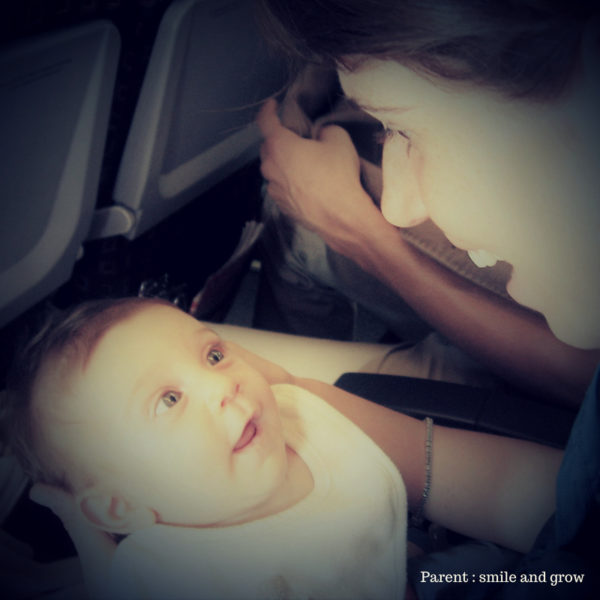
Let’s picture a smiling mother. Baby’s brain registers that mommy’s nervous system is activated in a positive way. So it also activates in a positive way, it synchronizes on the same length. Heart beat rate increases.
Beta-endorphines are thus released in the orbito-frontal part. What are those for you’ll wonder? Beta endorphines regulate glucose and insuline, which help neurons to grow. They are also natural opioids so they make us feel good!
Dopamine is also released in the prefrontal cortex, with its energizing and stimulating effect. All this process helps the expression of genes.
The more pleasant experiences we live, the better the genetic growth and development!
In fact, we find the most intense growth in the neural connections right between 6 and 12 months, when the attachment bond is formed and where interactions with parents are the most pleasurable ones.
All this theory on baby’s brain.. what for?
I know all this may sound out of topic, but if I may derive just one conclusion out if it is : new parent, take care of yourself.
Babies do need us fully for many months. The relationships they’ll experience during their first 12 months are somewhat critical for their future lives. It may be overwhelming for parents!
Seek the most help you can, so that you can be available for your baby. Give yourself grace. You will not be a perfect parent anyways, what counts is the patterns you create, not the one exception.
Remember : when you smile, when you feel good, your baby does too.
What can we then do if our baby is very nervous then? Once we’ve checked on the classic physiological needs, we can “scan ourselves” to see whether we are ourselves nervous.
Then, be in contact with our baby, perceive his feelings, mimic them and put them into words. Finally, we can smile and say something as “Mommy/Daddy is here, everything will be fine”.
You can find some other tips in this article on the effects of parents’ stress on babies.
Smiling sends a positive, powerful message we are all wired to perceive and imitate; be it to babies as well as to the adults! (Now I admit, every time I smile, I think about endorphins and dopamine invading brain, and that makes me smile even more 🙂 ).
Don’t worry, be happy!
(References for this article : Daniel Goleman, “Social Intelligence”, chapter 1; Sue Gerhardt “Why love matters“, in particular pages 43 to 62)
If you liked this post, please share it with your friends! Help our community grow 🙂
